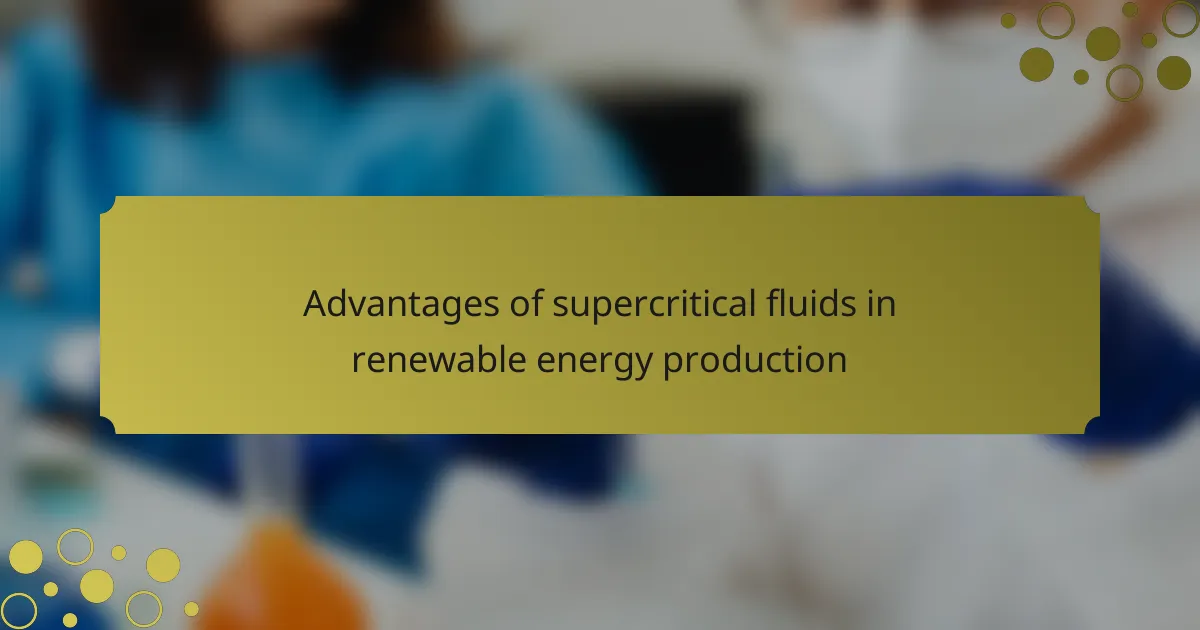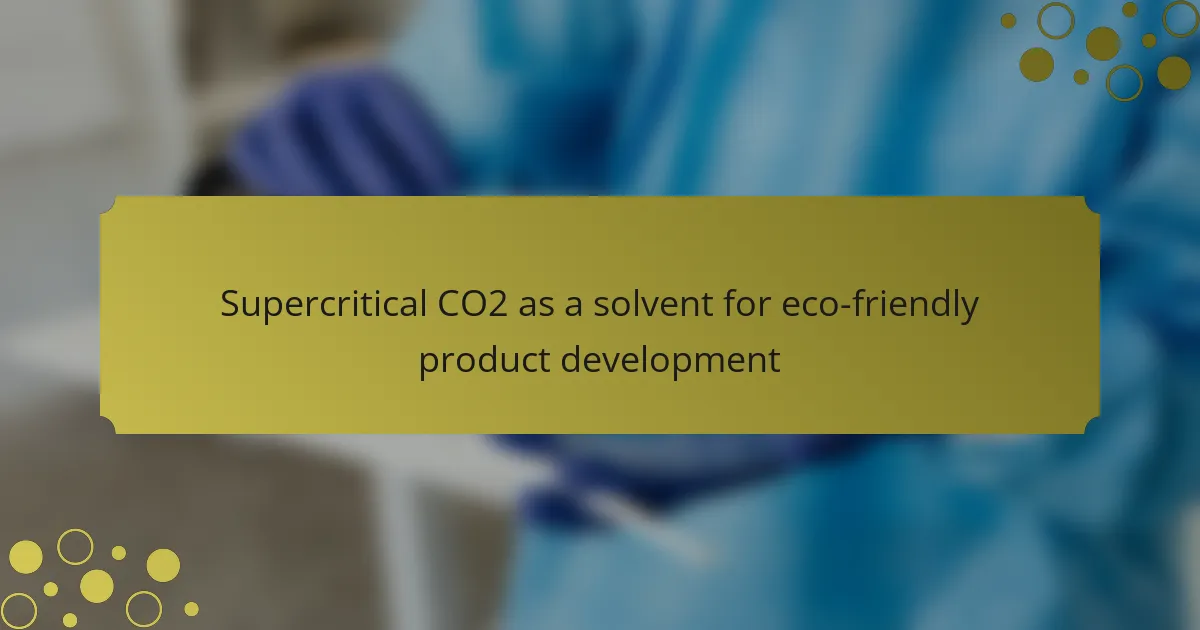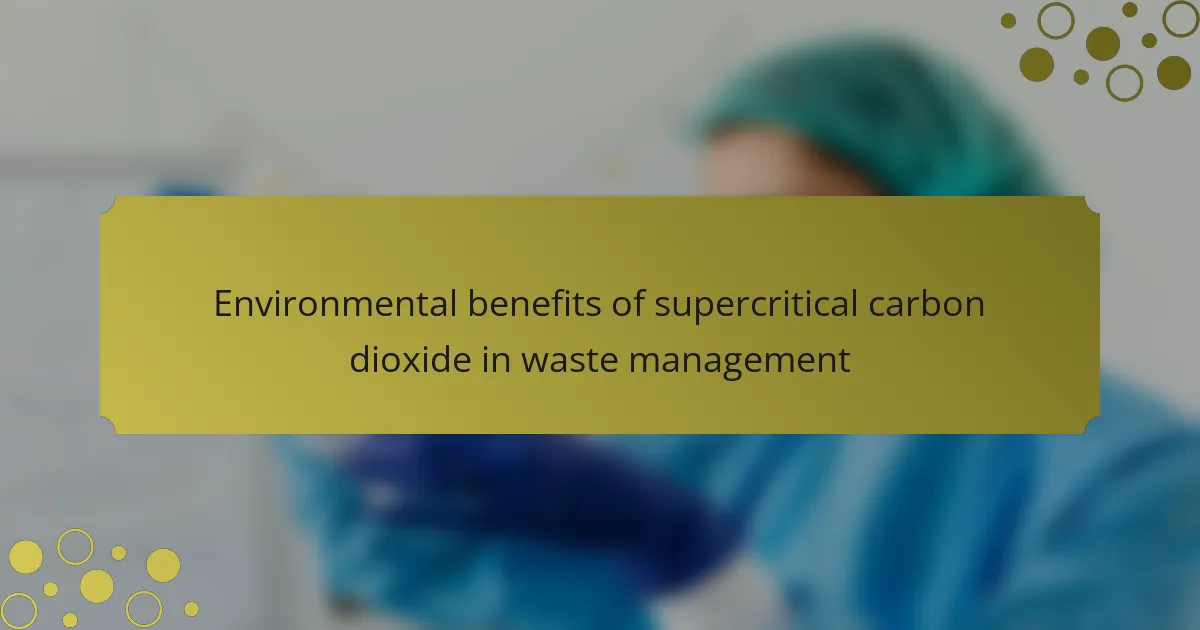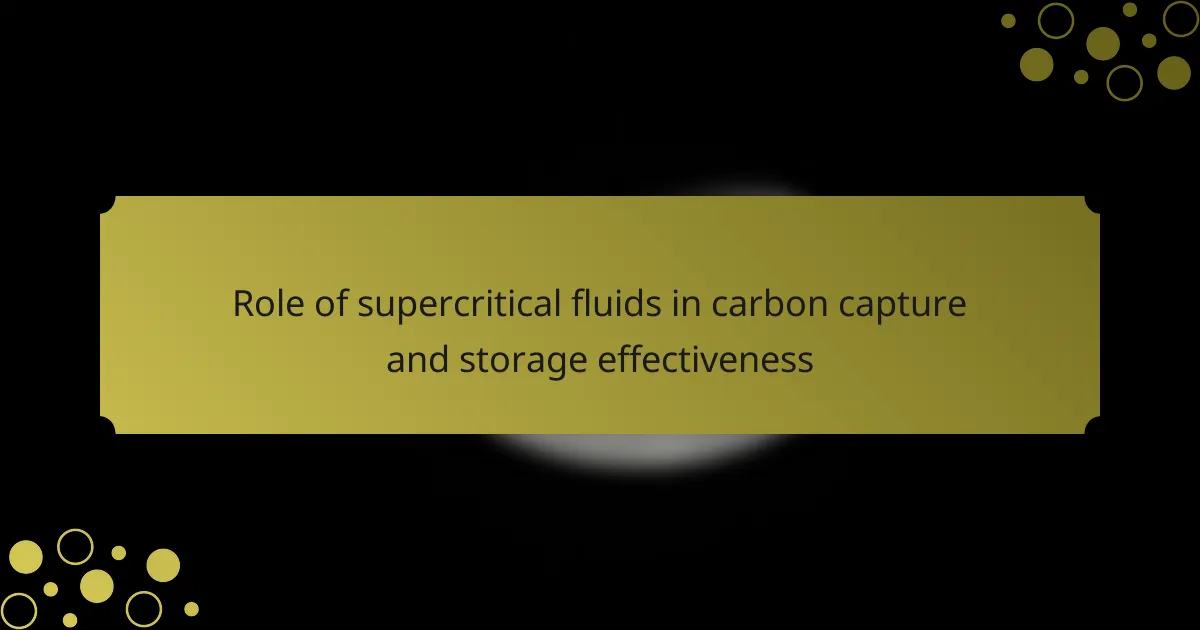Supercritical fluids, defined as substances that exist above their critical temperature and pressure, play a significant role in bioremediation by enhancing the extraction and degradation of contaminants from soil and water. Their unique characteristics, such as high diffusivity and low viscosity, facilitate efficient transport of pollutants, making supercritical carbon dioxide a common choice for extracting organic compounds. Various methods, including extraction, oxidation, and microbial enhancement, utilize supercritical fluids to improve the bioavailability of contaminants and promote faster remediation times. Research indicates that employing supercritical fluids not only reduces the need for traditional chemical solvents but also leads to more effective environmental cleanup by minimizing toxicity and secondary waste generation.
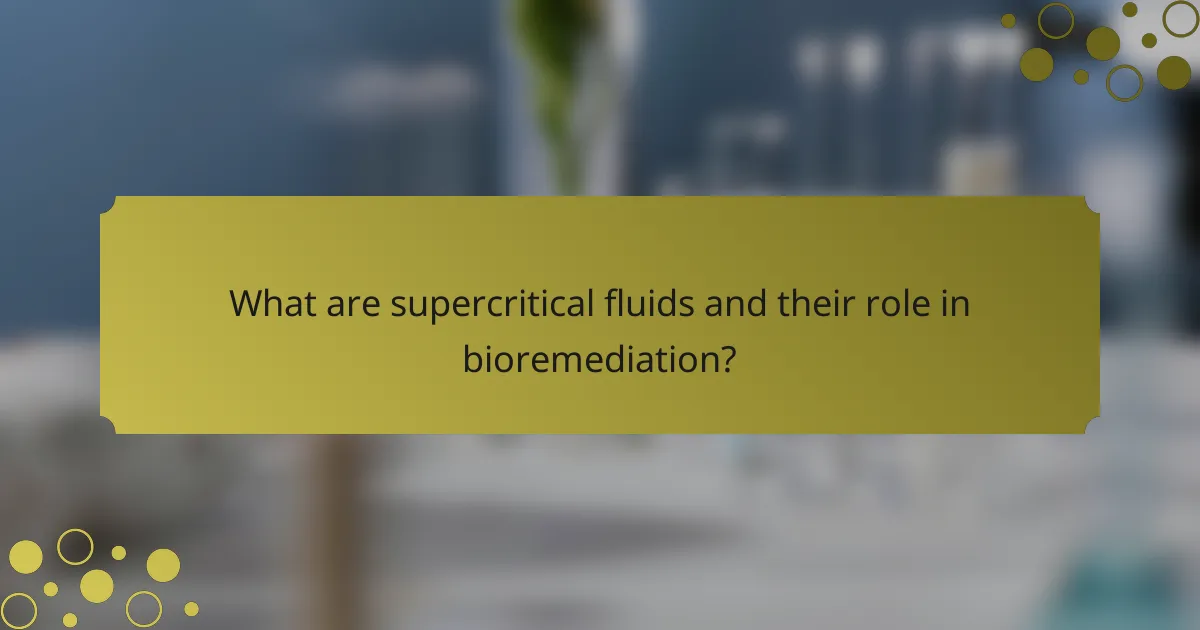
What are supercritical fluids and their role in bioremediation?
Supercritical fluids are substances at a temperature and pressure above their critical points, where distinct liquid and gas phases do not exist. In bioremediation, supercritical fluids can enhance the extraction of contaminants from soil and water. Their unique properties, such as high diffusivity and low viscosity, allow for efficient transport of pollutants. For example, supercritical carbon dioxide is often used to extract organic compounds from contaminated sites. Studies show that supercritical fluids can improve the degradation rates of hazardous substances by facilitating microbial access. This method reduces the need for traditional chemical solvents, making it an environmentally friendly option. Research has demonstrated that using supercritical fluids can lead to more effective and faster clean-up processes in contaminated environments.
How do supercritical fluids differ from traditional solvents?
Supercritical fluids differ from traditional solvents primarily in their unique physical properties. Supercritical fluids exist above their critical temperature and pressure, allowing them to exhibit properties of both liquids and gases. This dual behavior results in enhanced solvation capabilities compared to traditional solvents. For example, supercritical carbon dioxide can dissolve nonpolar compounds effectively, which is often challenging for polar solvents. Additionally, supercritical fluids have lower viscosities and higher diffusivities, facilitating faster mass transfer during extraction processes. Their tunable properties can be adjusted by altering pressure and temperature, providing greater versatility in applications. Traditional solvents typically have fixed properties, limiting their adaptability.
What are the physical properties of supercritical fluids?
Supercritical fluids exhibit unique physical properties that differentiate them from gases and liquids. They have distinct density, which can be adjusted by changing temperature and pressure. Supercritical fluids also possess high diffusivity, allowing them to penetrate materials easily. Additionally, they have low viscosity, facilitating efficient mass transfer. Their solvation properties are tunable, enabling them to dissolve a wide range of substances. These fluids can also exhibit high thermal conductivity, enhancing heat transfer during processes. The combination of these properties makes supercritical fluids effective in applications such as extraction and bioremediation.
Why are these properties beneficial for bioremediation processes?
Supercritical fluids possess unique properties that enhance bioremediation processes. Their low viscosity allows for improved mass transfer, facilitating the movement of contaminants to microbial populations. Supercritical fluids also exhibit high diffusivity, which increases the [censured] of these fluids into contaminated matrices. This characteristic promotes better interaction with pollutants, leading to more effective degradation. Additionally, the tunable density of supercritical fluids enables selective solvation of various contaminants. This selectivity can enhance the bioavailability of pollutants to microorganisms. Studies have shown that using supercritical carbon dioxide can significantly improve the degradation rates of organic contaminants. Therefore, these properties contribute to more efficient and effective bioremediation strategies.
What types of contaminants can be treated using supercritical fluids?
Supercritical fluids can treat a variety of contaminants, including organic pollutants, heavy metals, and pharmaceuticals. Organic pollutants, such as hydrocarbons and pesticides, are effectively solubilized in supercritical fluids. Heavy metals can be extracted by complexing agents dissolved in supercritical fluids. Pharmaceuticals, particularly those that are hydrophobic, can also be removed using this method. Research shows that supercritical fluid extraction can achieve higher recovery rates compared to traditional methods. This effectiveness is due to the unique properties of supercritical fluids, which enhance solubility and mass transfer.
How effective are supercritical fluids against organic pollutants?
Supercritical fluids are highly effective against organic pollutants. They can dissolve a wide range of organic compounds due to their unique properties. Supercritical fluids, such as carbon dioxide, have low viscosity and high diffusivity. This allows them to penetrate contaminated materials easily. Studies show that supercritical fluid extraction can remove up to 90% of certain organic pollutants. Their effectiveness is enhanced by adjusting temperature and pressure conditions. This adaptability makes them suitable for various pollutants, including oils and solvents. Research indicates that supercritical fluids can also facilitate the degradation of pollutants through enhanced mass transfer.
What is the impact on heavy metals and inorganic contaminants?
Heavy metals and inorganic contaminants negatively impact environmental health. They can accumulate in soil and water, leading to toxicity in living organisms. Supercritical fluids can effectively extract these contaminants from polluted sites. This method enhances the bioavailability of heavy metals for microbial degradation. Studies show that supercritical fluid extraction reduces contaminant levels significantly. For instance, a study published in the Journal of Hazardous Materials demonstrated a 90% reduction of lead in contaminated soil using supercritical carbon dioxide. This extraction method also minimizes secondary pollution risks. Overall, the use of supercritical fluids in bioremediation offers a promising solution for mitigating heavy metal contamination.
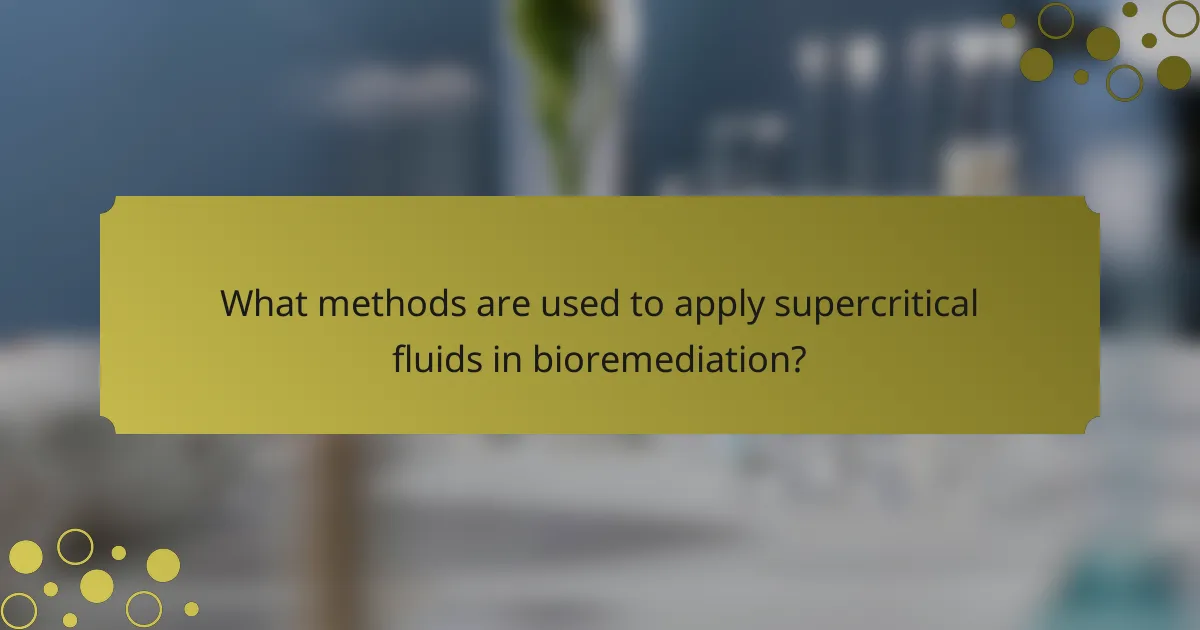
What methods are used to apply supercritical fluids in bioremediation?
Supercritical fluids are applied in bioremediation through various methods including extraction, oxidation, and microbial enhancement. Extraction involves using supercritical carbon dioxide to dissolve and remove contaminants from soil and water. Oxidation utilizes supercritical fluids to enhance the degradation of pollutants by providing a reactive environment. Microbial enhancement leverages supercritical fluids to improve the bioavailability of contaminants, facilitating microbial degradation. These methods have been shown to effectively reduce toxic substances in contaminated environments, leading to improved bioremediation outcomes.
How is the supercritical fluid extraction process conducted?
Supercritical fluid extraction (SFE) is conducted by utilizing a supercritical fluid, typically carbon dioxide. The process begins by heating and pressurizing the fluid above its critical temperature and pressure. This creates a state where the fluid exhibits properties of both a gas and a liquid. The supercritical fluid is then passed through the material containing the target compounds.
During this passage, the supercritical fluid dissolves the desired compounds. The extraction occurs in a closed system to maintain pressure and temperature. Once the extraction is complete, the fluid is depressurized, causing the dissolved compounds to precipitate out. The extracted substances can then be collected and analyzed.
SFE is favored for its efficiency and ability to selectively extract compounds without leaving harmful residues. Studies have shown that SFE can effectively remove pollutants from contaminated environments, making it a valuable method in bioremediation efforts.
What equipment is necessary for supercritical fluid extraction?
The equipment necessary for supercritical fluid extraction includes a high-pressure pump, a pressure vessel, a temperature control system, and a collection chamber. The high-pressure pump is essential for delivering the supercritical fluid at the required pressure. The pressure vessel holds the sample and the supercritical fluid during extraction. A temperature control system maintains the desired temperature for optimal extraction conditions. The collection chamber is where the extracted compounds are gathered after the process. These components work together to ensure efficient extraction of target compounds from various materials.
What are the steps involved in the extraction process?
The extraction process using supercritical fluids involves several key steps. First, the supercritical fluid is prepared by heating and pressurizing it. This creates a state where the fluid exhibits properties of both liquids and gases. Next, the target material is combined with the supercritical fluid in an extraction vessel. The supercritical fluid penetrates the material, dissolving the desired compounds. After sufficient extraction time, the mixture is depressurized to separate the supercritical fluid from the extracted compounds. Finally, the extracted compounds are collected for further analysis or use. This method is efficient and environmentally friendly, as it often uses carbon dioxide, which is non-toxic and recyclable.
What are the advantages of using supercritical fluids in bioremediation methods?
Supercritical fluids offer several advantages in bioremediation methods. They enhance the solubility of organic contaminants, making them more accessible for microbial degradation. Supercritical fluids can penetrate porous materials effectively, improving the extraction of pollutants from soil and water. Their tunable properties allow for optimized extraction conditions, increasing efficiency. Additionally, supercritical fluids reduce the need for hazardous solvents, promoting a safer environment. Studies indicate that using supercritical carbon dioxide can significantly increase the degradation rates of contaminants. This method also minimizes residual waste, contributing to a cleaner bioremediation process.
How do supercritical fluids enhance the efficiency of contaminant removal?
Supercritical fluids enhance the efficiency of contaminant removal by acting as effective solvents. They possess unique properties, such as high diffusivity and low viscosity. This allows them to penetrate contaminants more effectively than traditional solvents. Supercritical carbon dioxide, for instance, can dissolve non-polar compounds, making it suitable for extracting hydrophobic pollutants. Studies show that using supercritical fluids can increase extraction yields significantly. For example, research indicates that supercritical CO2 can improve the removal of organic pollutants by up to 90%. These properties enable faster and more efficient contaminant extraction processes in bioremediation efforts.
What environmental benefits arise from using supercritical fluids?
Supercritical fluids offer several environmental benefits. They can effectively dissolve and extract pollutants from contaminated sites. This process minimizes the use of harmful solvents, reducing environmental toxicity. Supercritical fluids also enable efficient extraction of valuable compounds from waste materials. Their high diffusivity allows for rapid [censured] into porous media, enhancing remediation speed. Additionally, they can operate at lower temperatures, conserving energy. Research shows that using supercritical CO2 in bioremediation can reduce greenhouse gas emissions compared to traditional methods. Overall, supercritical fluids contribute to cleaner, more sustainable environmental practices.
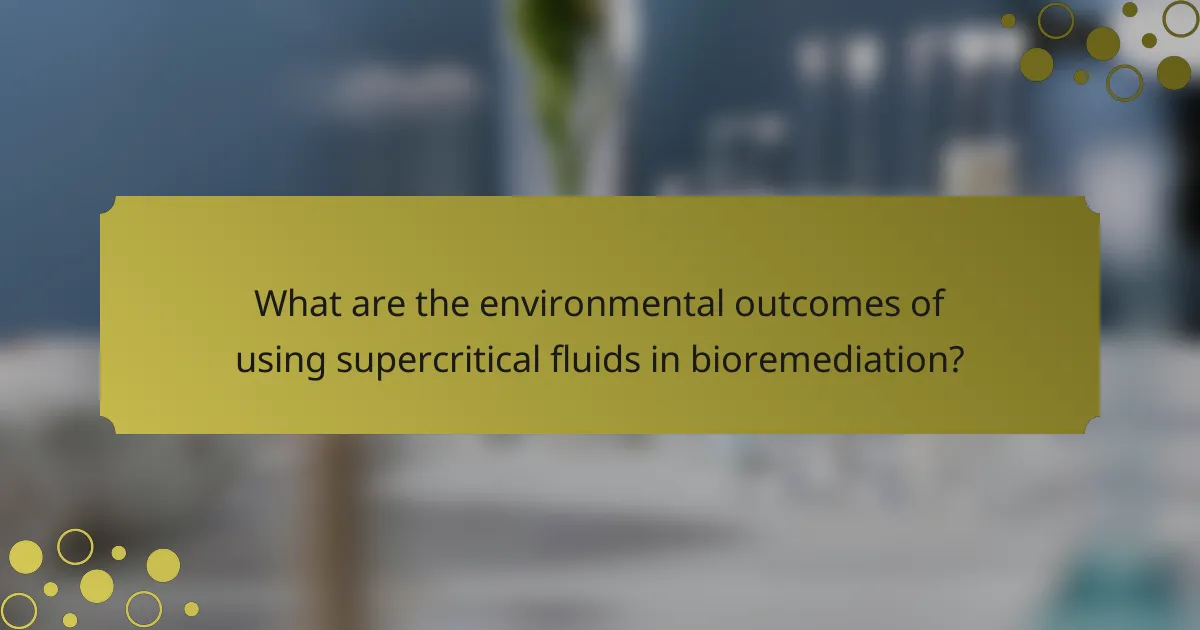
What are the environmental outcomes of using supercritical fluids in bioremediation?
The environmental outcomes of using supercritical fluids in bioremediation include enhanced contaminant extraction and reduced toxicity. Supercritical fluids can efficiently dissolve organic pollutants. This property allows for effective removal from contaminated sites. Studies show that supercritical carbon dioxide can extract heavy metals and organic compounds. This method minimizes secondary waste generation. Additionally, it promotes the degradation of pollutants into less harmful substances. The use of supercritical fluids can lead to faster remediation times compared to traditional methods. Overall, this technology offers a more sustainable approach to environmental cleanup.
How do supercritical fluids affect soil and water quality?
Supercritical fluids can enhance soil and water quality through their unique properties. They act as effective solvents, facilitating the extraction of contaminants from soil and water. This process can remove pollutants such as heavy metals and organic compounds. Research indicates that supercritical carbon dioxide is particularly effective in dissolving hydrophobic contaminants. A study by Zhang et al. (2020) found that using supercritical fluids improved the degradation of toxic substances in contaminated sites. Additionally, supercritical fluids can promote microbial activity, aiding in bioremediation efforts. This leads to improved soil health and water quality overall.
What changes can be observed in microbial activity post-treatment?
Post-treatment microbial activity typically shows increased diversity and abundance. Supercritical fluid treatments can enhance the bioavailability of contaminants. This increased bioavailability allows microbes to access nutrients more effectively. Consequently, microbial metabolism rates often rise. Specific microbial populations may thrive due to the altered environmental conditions. For example, hydrocarbon-degrading bacteria can proliferate in treated sites. Studies indicate that treated environments often display higher enzymatic activity. These changes collectively contribute to improved bioremediation outcomes.
How do supercritical fluids influence ecosystem health?
Supercritical fluids can enhance ecosystem health by facilitating the removal of pollutants. They act as efficient solvents for extracting contaminants from soil and water. This extraction process reduces the toxicity of hazardous substances in ecosystems. Supercritical carbon dioxide, for example, is non-toxic and leaves no harmful residues. Studies show that using supercritical fluids in bioremediation can significantly lower pollutant levels. The method has been proven effective in degrading organic pollutants. This leads to improved soil and water quality. Consequently, healthier ecosystems support diverse flora and fauna.
What are the long-term effects of supercritical fluid bioremediation?
Supercritical fluid bioremediation can lead to several long-term effects on the environment. It enhances the degradation of pollutants, resulting in cleaner soil and water. This method can improve soil health by restoring microbial activity. It also reduces the toxicity of contaminants over time. Long-term monitoring shows sustained reduction in pollutant levels. Furthermore, it can lead to the recovery of ecosystems affected by contamination. Studies indicate that supercritical fluid techniques can be more effective than traditional methods. These benefits contribute to overall environmental sustainability.
How sustainable is the use of supercritical fluids in environmental cleanup?
The use of supercritical fluids in environmental cleanup is considered sustainable. Supercritical fluids, such as carbon dioxide, have low toxicity and can replace hazardous solvents. They enhance the extraction of contaminants from soil and water. This method reduces the volume of waste generated during cleanup. It also minimizes energy consumption compared to traditional methods. Studies show that supercritical CO2 can effectively remove pollutants like hydrocarbons. This technique leads to less environmental impact and promotes resource recovery. Overall, supercritical fluids offer a viable, eco-friendly solution for environmental remediation.
What are the potential risks associated with supercritical fluid use?
The potential risks associated with supercritical fluid use include high pressure and temperature hazards. Supercritical fluids operate under extreme conditions, which can lead to equipment failure. Equipment failures may result in leaks or explosions. Additionally, the solvents used can be toxic or hazardous. Exposure to these solvents can pose health risks to workers. Environmental contamination may occur if supercritical fluids are not managed properly. Regulatory compliance is also a concern, as improper use may lead to legal penalties. Overall, careful management is essential to mitigate these risks.
What best practices should be followed when using supercritical fluids in bioremediation?
Use supercritical fluids in bioremediation by following established best practices. First, select the appropriate supercritical fluid based on the contaminants present. Carbon dioxide is commonly used due to its low toxicity and effectiveness. Second, optimize temperature and pressure conditions for maximum solubility and extraction efficiency. Maintaining specific parameters enhances the fluid’s ability to dissolve contaminants. Third, conduct thorough pre-treatment of contaminated materials to improve fluid [censured]. This step can increase the overall effectiveness of the bioremediation process. Fourth, monitor the bioremediation process continuously to assess the effectiveness of contaminant removal. Regular analysis ensures timely adjustments to the process. Finally, ensure proper disposal of residual materials after treatment to prevent secondary contamination. These best practices enhance the efficiency and safety of using supercritical fluids in bioremediation.
How can practitioners optimize the use of supercritical fluids for effective results?
Practitioners can optimize the use of supercritical fluids by adjusting temperature and pressure parameters. This ensures that the fluids maintain their supercritical state, enhancing solubility and extraction efficiency. Selecting appropriate solvents is crucial for targeting specific contaminants. For instance, carbon dioxide is often used due to its low toxicity and effectiveness. Additionally, practitioners should consider the flow rate to maximize contact between the supercritical fluid and the contaminants. Research shows that optimized conditions can lead to improved extraction yields. A study by McHugh and Krukonis (2013) highlights the importance of these parameters in real-world applications. By fine-tuning these variables, practitioners can achieve more effective bioremediation outcomes.
What common challenges should be anticipated and addressed?
Common challenges in using supercritical fluids for bioremediation include high operational costs, limited scalability, and potential toxicity. High operational costs arise from the need for specialized equipment and energy-intensive processes. Limited scalability is a concern as small-scale laboratory results may not translate effectively to larger field applications. Potential toxicity of supercritical fluids can affect both target organisms and surrounding ecosystems. Additionally, the complexity of fluid behavior under varying conditions can complicate process optimization. These challenges necessitate careful planning and consideration to ensure effective bioremediation outcomes.
Supercritical fluids, particularly supercritical carbon dioxide, play a significant role in bioremediation by enhancing the extraction and degradation of contaminants from soil and water. This article examines the unique physical properties of supercritical fluids that differentiate them from traditional solvents, including their tunable solvation capabilities and efficient mass transfer. It also explores the various methods employed in bioremediation, such as extraction and microbial enhancement, and highlights the environmental benefits, including improved soil and water quality. Furthermore, the article addresses the long-term effects and sustainability of using supercritical fluids in environmental cleanup, while acknowledging potential risks and best practices for effective implementation.
